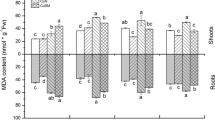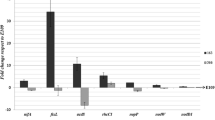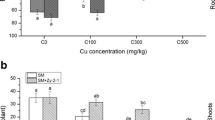Abstract
Inoculation with a mercury (Hg)-resistant Bradyrhizobium canariense strain (L7AH) confers on Lupinus albus the ability to grow under high concentrations of Hg and to accumulate this heavy metal. To elucidate the mechanism/s implicated in the acquisition of this tolerance, lupins were inoculated with resistant (L7AH) and sensitive (L3) strains and fed with different Hg solutions (0–200 μM HgCl2). Mercury application resulted in cellular alterations in leaves and nodules, depending on the strain inoculated. Mesophyll cell chloroplasts from L7AH-inoculated plants treated with Hg showed similar structure to those in control plants, while those of L3-inoculated plants treated with Hg showed a large increase in the number and size of starch granules. This resulted in a large increase in chloroplast and cell size which produced altered grana distribution with a totally disorganized thylakoid structure and clear signs of degradation. The preservation of the distribution and morphology of chloroplasts in L7AH-inoculated plants may be a reason why the photosynthetic efficiency remained unchanged even after treatment with 200 μM of Hg. Mercury exposure produced changes in L3-infected nodule ultrastructure, with evident signs of degradation, especially in bacteroids. However, only slight alterations of nodule morphology were noticed in L7AH-infected nodules. X-ray microanalysis showed that, while Hg was present in the nodules formed by L3, in both cortex and infected zone, in those formed by L7AH only low levels of Hg in the outermost layers of the cortex were detected. The exclusion of Hg from the infected zone together with the conservation of the symbiosome structure in nodules from L7AH-inoculated plants may explain the maintenance of nitrogenase activity.








Similar content being viewed by others
References
Bethlenfalvay GJ, Phillips DA (1978) Interactions between symbiotic nitrogen fixation, combined-N application and photosynthesis in Pisum sativum. Physiol Plant 42:119–123
Cakmak I (2000) Role of zinc in protecting plant cells from reactive oxygen species. New Phytol 146:185–205
Carpena R, Vázquez S, Esteban E, Fernández-Pascual M, de Felipe MR, Zornoza P (2003) Cadmium-stress in white lupin: effects on nodule structure and functioning. Plant Physiol Biochem 41:911–919
Chen J, Yang ZM (2012) Mercury toxicity, molecular response and tolerance in higher plants. Biometals 25:847–857
de Felipe MR, Fernández-Pascual M, Pozuelo JM (1987) Effects of the herbicides lindex and simazine on chloroplast and nodule development, nodule activity and grain yield in Lupinus albus L. Plant Soil 101:99–105
de Lorenzo C, Fernández-Pascual M, de Felipe MR (1994) Protective enzymes against active oxygen species during nitrate-induced senescence of Lupinus albus nodules. J Plant Physiol 144:633–640
de Lorenzo C, Fernández-Pascual M, de Felipe MR (1998) Subcellular localization of glycoprotein epitopes during the development of lupin root nodules. Protoplasma 201:71–84
de María N, de Felipe MR, Fernández-Pascual M (2005) Alterations induced by glyphosate on lupin photosynthetic apparatus and nodule ultrastructure and some oxygen diffusion related proteins. Plant Physiol Biochem 43:985–996
de María N, Guevara A, Serra MT, García-Luque I, González A, de Felipe MR, Fernández-Pascual M (2007) Putative porin of Bradyrhizobium sp. (Lupinus) bacteroids induced by glyphosate. Appl Environ Microbiol 73:5075–5082
Esteban E, Moreno E, Peñalosa J, Cabrero José I, Millan R, Zornoza P (2008) Short and long-term uptake of Hg in white lupin plants: kinetics and stress indicators. Environ Exp Bot 62:316–322
Fedorova E, Redondo FJ, Koshiba T, de Felipe MR, Pueyo JJ, Lucas MM (2005) Aldehyde oxidase (AO) in the root nodules of Lupinus albus and Medicago truncatula: identification of AO in meristematic and infection zones. Mol Plant-Microbe Interact 18:405–413
Fernández-Pascual M, Serra MT, Pozuelo JM, de Felipe MR (1988) Effects of cianazine and linuron on chloroplast development, nodule activity and protein metabolism in Lupinus albus L. J Plant Physiol 133:288–294
Fernández-Pascual M, de Lorenzo C, Pozuelo JM, de Felipe MR (1992) Alterations induced by four herbicides on lupin nodule cortex structure, protein metabolism and some senescence-related enzymes. J Plant Physiol 140:385–390
Fernández-Pascual M, de Lorenzo C, de Felipe MR, Rajalakshmi S, Gordon AJ, Thomas BJ, Minchin FR (1996) Possible reasons for relative salt stress tolerance in nodules of white lupin cv. Multolupa. J Exp Bot 47:1709–1716
Ge C, Ding Y, Wang Z, Wan D, Wang Y, Shang Q, Luo S (2009) Responses of wheat seedlings to cadmium, mercury and trichlorobenzene stresses. J Environ Sci 21:806–813
Geigenberger P (2011) Regulation of starch biosynthesis in response to a fluctuating environment. Plant Physiol 155:1566–1577
González-Sama A, Lucas MM, de Felipe MR, Pueyo JJ (2004) An unusual infection mechanism and nodule morphogenesis in white lupin (Lupinus albus). New Phytol 163:371–338
Hernández-Jiménez MJ, Lucas MM, de Felipe MR (2002) Antioxidant defense and damage in senescing lupin nodules. Plant Physiol Biochem 40:645–657
Hess FD (1980) Influence of specimen topography on microanalysis. In: Hayat, M.A. (Ed) X-Ray Microanalysis in Biology. Macmillan publishers LTD, London 241–261
Humme E, Osterrieder A, Robinson DG, Hawes C (2010) Inhibition of Golgi function causes plastid starch accumulation. J Exp Bot 61:2603–2614
Iovdijova A, Bencko V (2010) Potential risk of exposure to selected xenobiotic residues and their fate in the food chain - part I: classification of xenobiotics. Ann Agric Environ Med 17:183–192
James EK, Minchin FR, Iannetta PPM, Sprent JI (1997) Temporal relationships between nitrogenase and intercellular glycoprotein in developing white lupin nodules. Ann Bot 79:493–503
Minchin FR, Pate JS (1973) Carbon balance of a legume and functional economy of its root nodules. J Exp Bot 24:259--271
Montero-Palomero MB, Martín-Barranco A, Escobar C, Hernández LE (2014) Early transcriptional responses to mercury: a role for ethylene in mercury-induced stress. New Phytol 201:116–130
Nair S, Jha PK, Babu CR (1993) Variation in poly-β-hydroxybutyrate synthesis in rhizobia reflects strain differentiation and temperature regulation. J Basic Microbiol 33:35–39
Panou-Filotheou H, Bosabalidis AM, Karataglis S (2001) Effects of Cu toxicity on leaves of oregano (Origanum vulgare subsp. Hirtum). Ann Bot 88:207–214
Pastor J, Hernández AJ, Prieto N, Fernández-Pascual M (2003) Accumulating behaviour of Lupinus albus L. growing in a normal and a decalcified calcic luvisol polluted with Zn. J Plant Physiol 160:1455–1463
Quartacci MF, Pinzino C, Sgherri CLM, Dalla VF, Navari-Izzo F (2000) Growth in excess copper induces changes in the lipid composition and fluidity of PSII-enriched membranes in wheat. Physiol Plant 108:87–93
Quiñones MA, Ruiz-Díez B, Fajardo S, López-Berdonces MA, Higueras PL, Fernández-Pascual M (2013) Lupinus albus plants acquire mercury tolerance when inoculated with an Hg-resistant Bradyrhizobium strain. Plant Physiol Biochem 73:168–175
Rellán-Álvarez R, Ortega-Villasante C, Álvarez-Fernandez A, del Campo FF, Hernández LE (2006) Stress responses of Zea mays to cadmium and mercury. Plant Soil 279:41–50
Rodríguez L, Rincón J, Asencio I, Rodríguez-Castellanos L (2007) Capability of selected crop plants for shoot mercury accumulation from polluted soils: phytoremediation perspectives. Int J Phytorem 9:1–13
Ruiz-Díez B, Quiñones MA, Fajardo S, López MA, Higueras P, Fernández-Pascual M (2012a) Mercury-resistant rhizobial bacteria isolated from nodules of leguminous plants growing in high Hg-contaminated soils. Appl Microbiol Biotechnol 96:543–554
Ruiz-Díez B, Fajardo S, de Felipe MR, Fernández-Pascual M (2012b) Characterization of rhizobia from legumes of agronomic interest grown in semi-arid areas of Central Spain relates genetic differences to soil properties. J Basic Microbiol 52:66–78
Sánchez-Pardo B, Fernández-Pascual M, Zornoza P (2012) Copper microlocalisation, ultrastructural alterations and antioxidant responses in the nodules of white lupin and soybean plants grown under conditions of copper excess. Environ Exp Bot 8:52–60
Sánchez-Pardo B, Fernández-Pascual M, Zornoza P (2014) Copper microlocalisation and changes in leaf morphology, chloroplast ultrastructure and antioxidative response in white lupin and soybean grown in copper excess. J Plant Res 127:119–129
Tang C, Robson AD, Dilworth MJ, Kuo J (1992) Microscopic evidence on how iron deficiency limits nodule initiation in Lupinus angustifolius L. New Phytol 121:457–467
Vázquez S, Fernández-Pascual M, Sánchez-Pardo B, Carpena R, Zornoza P (2007) Subcellular compartmentation study of cadmium in white lupin plants by energy dispersive X-ray microanalysis. J Plant Physiol 167:1235–1239
Wierzchos J, Ascaso C (1996) Morphological and chemical features of bioweathered granitic biotite induced by lichen activity. Clays Clay Miner 44:652–657
Zornoza P, Vázquez S, Esteban E, Fernández-Pascual M, Carpena R (2002) Cd-stress in nodulated white lupin: strategies to avoid toxicity. Plant Physiol Biochem 40:1003–1009
Zornoza P, Millán R, Sierra MJ, Seco A, Esteban E (2010) Efficiency of white lupin in the removal of mercury from contaminated soils: soil and hydroponic experiments. J Environ Sci 3:421–427
Acknowledgments
This work was supported by Junta de Comunidades de Castilla La-Mancha (POII10-0211-5015) and Ministerio de Economía y Competitividad (AGL2013-40758-R). BR-D was supported by the JCCL-M. The authors would like to thank Dr. F. Minchin for critical proof-reading of the manuscript. We thank V. Sousa-Egipsy for electron microscopy facilities.
Author information
Authors and Affiliations
Corresponding author
Additional information
Highlights
Mercury causes serious damage to the ultrastructure of chloroplasts and symbiosomes of lupin when inoculated with an Hg-sensitive Bradyrhizobium strain.
Mercury causes slight damage to the ultrastructure of chloroplasts and symbiosomes of lupin inoculated with an Hg-resistant Bradyrhizobium strain.
Mercury penetrates into the infected zone of nodules when lupin is inoculated with a sensitive Bradyrhizobium strain.
Mercury remains in the outermost cells of the nodule cortex when lupin is inoculated with a resistant Bradyrhizobium strain.
The Hg-resistant Bradyrhizobium strain protects lupin plants from damage caused by Hg.
Electronic supplementary material
ESM 1
(PPT 5.77 mb)
Rights and permissions
About this article
Cite this article
Ruiz-Díez, B., Quiñones, M.A., Fajardo, S. et al. Possible reasons for tolerance to mercury of Lupinus albus cv. G1 inoculated with Hg-resistant and sensitive Bradyrhizobium canariense strains. Symbiosis 67, 91–102 (2015). https://doi.org/10.1007/s13199-015-0362-y
Received:
Accepted:
Published:
Issue Date:
DOI: https://doi.org/10.1007/s13199-015-0362-y




